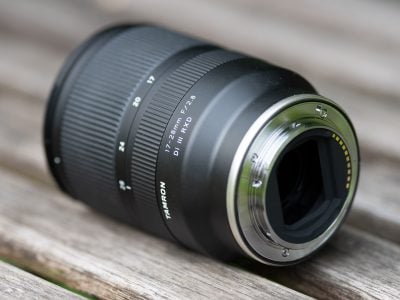Tamron 17-28mm f2.8 Di III review
-
-
Written by Thomas
Intro
The Tamron 17-28mm f2.8 Di III RXD (model A046) is a small and light non-stabilized wide-angle zoom lens with a constant f2.8 focal ratio that’s designed for Sony E-mount full-frame cameras. Announced in June 2019 it nicely complements Tamron’s 28-75mm f2.8 Di III RXD standard zoom from 2018. Crucially, it’s less than half the price of Sony’s high-end FE 16-35mm f2.8 G Master. Indeed price-wise, it’s closest to Sony’s FE 16-35mm f4.0 ZA, a Zeiss design that’s a whole stop slower in aperture. But then both Sony lenses offer a longer zoom range.
To find out whether the new Tamron 17-28mm f2.8 Di III rightfully earns a recommendation I tested it on the 42MP Sony A7R II body and compare it against the Sony FE 16-35mm f2.8 GM. So if you’re interested in how Tamron’s new wide-angle zoom lens performs, you’ve come to the right place!
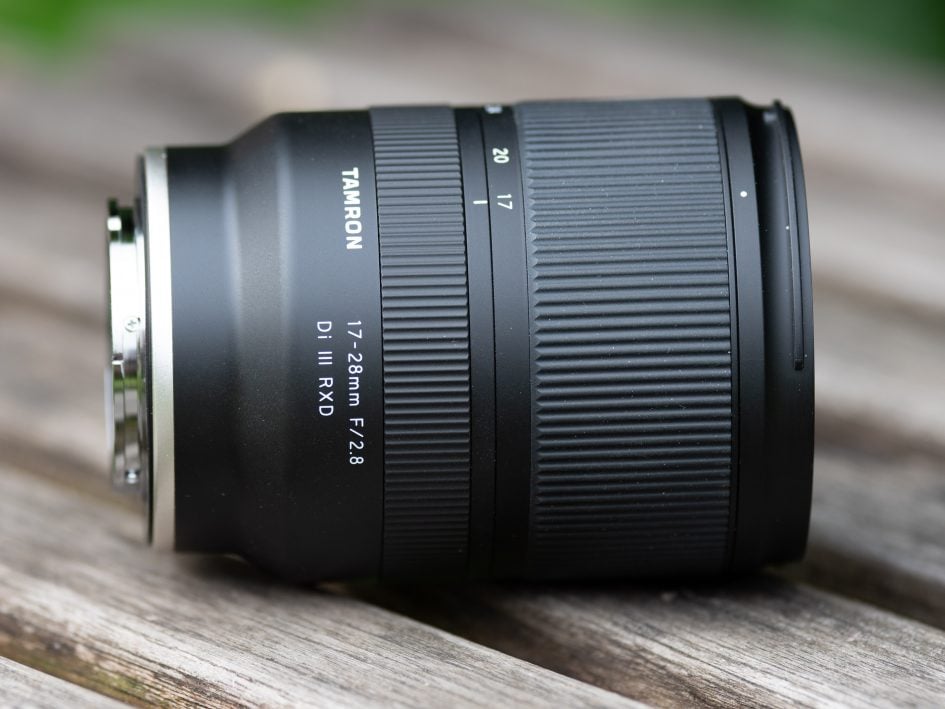
Facts from the catalog
As usual I’ll have a look at the technical data of the new Tamron 17-28mm f2.8 Di III first. I’ve rated the features with a [+] (or [++]), when it’s better than average or even state of the art, a [0] if it’s standard or just average, and [-] if there’s a disadvantage. For comparison I use the Sony FE 16-35mm f2.8 GM (“Sony GM” for short) and the Sony FE 16-35mm f4.0 ZA OSS (“Sony ZA”).
Size (diameter x length): 73 x 99mm (2.9 x 3.9in.) plus 25mm for the lens hood which is 87mm in diameter. Zooming does not change the length of the lens. The Sony GM is much larger at 89 x 122mm, the Sony ZA is 78x99mm, both without lens hood. [+]
Weight: 420g (14.8 oz.) plus 22g for the lens hood. This is pretty light for an f2.8 zoom lens. The Sony GM is 680g + 31g lens hood, the Sony ZA is 518g + 31g lens hood. [+]
Optics: 13 elements (including 3 special dispersion and 3 aspherical elements) in 11 groups similar to the Sony ZA (12/10). The Sony GM has a more complex optical design (16/13). [+]
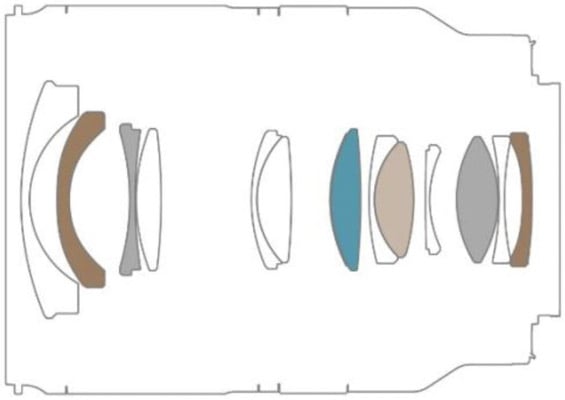
Closest focus distance is 0.23m (9.1in.) with a magnification of 1:4.5 at 28mm focal length using manual focus. This is quite good but you have a working distance of only 11cm (4.3in.). At the wide end the new Tamron even goes down to 1:4.3 but naturally the working distance shrinks even further to a meager 6cm (2.4in.). A magnification of 1:10 is achieved at 0.38m (1.2ft.) giving a working distance of 0.23m (9.1in.) with lens hood attached. The Sony GM and the Sony ZA achieve maximum magnification of 1:5.3 at 0.28m. [+]
Filter-thread: 67mm which is much smaller and cheaper than the 82mm filters the Sony GM needs. The Sony ZA uses 72mm filters. [+]
Image stabilization: The lens itself offers no optical stabilization just like the Sony GM. But modern Sony bodies provide built-in sensor-shift stabilization over 5 axis. The Sony ZA has its own optical stabilization. [0]
Auto focus: Yes. Manual-focus override is by simply turning the focus ring. The focus ring has a variable gearing that allows for very precise manual focus when turned slowly. Unfortunately this makes smooth focus pulling for videographers pretty hard. The Sony GM has an additional focus hold button and offers a linear gearing. [+]
Covers full frame or smaller. Same with the competition. [+]
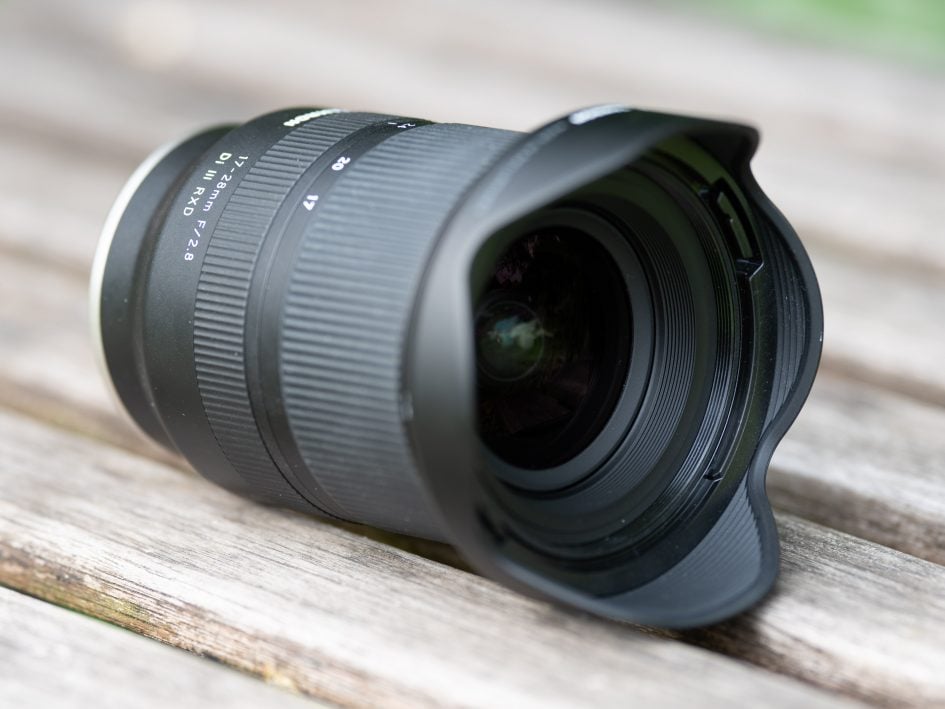
Price: The new Tamron is listed at 1000 EUR (incl. 19% VAT) / 900 USD. This is less than half the price of the Sony G-Master which goes for a whopping 2240 EUR / 2200 USD while the Sony ZA comes at 1050 EUR / 1350 USD. [+]
Comes without pouch/strap but the lens hood is included and reversible for transport. The Sony GM and ZA have a nice lens case. [0]
Aperture ring: No, just like the Sony GM and ZA. [0]
Sealing: yes, a rubber grommet at the lens-mount plus further weather-sealing throughout the construction and fluorine coating on the front lens for easier cleaning. Similar to the Sony GM and ZA. [+]
The score in the “features-department” is 0[-]/3[0]/9[+]. So the lens has a very good feature set. Especially noteworthy is its small size and weight considering its constant f2.8 focal ratio. Tamron touts that carrying both their 17-28/2.8 plus their 28-75/2.8 zoom lenses is less than 1 kg. Both lenses also have the same lens cap and filter size. But Tamron is giving up on zoom range which is only 17-28mm versus the more usual 16-35mm. So the Tamron’s narrowest angle of view is 75 degrees versus 63 degrees of the alternatives reaching 35mm focal length (see comparison of coverage below).
Two wide-angle zoom lenses
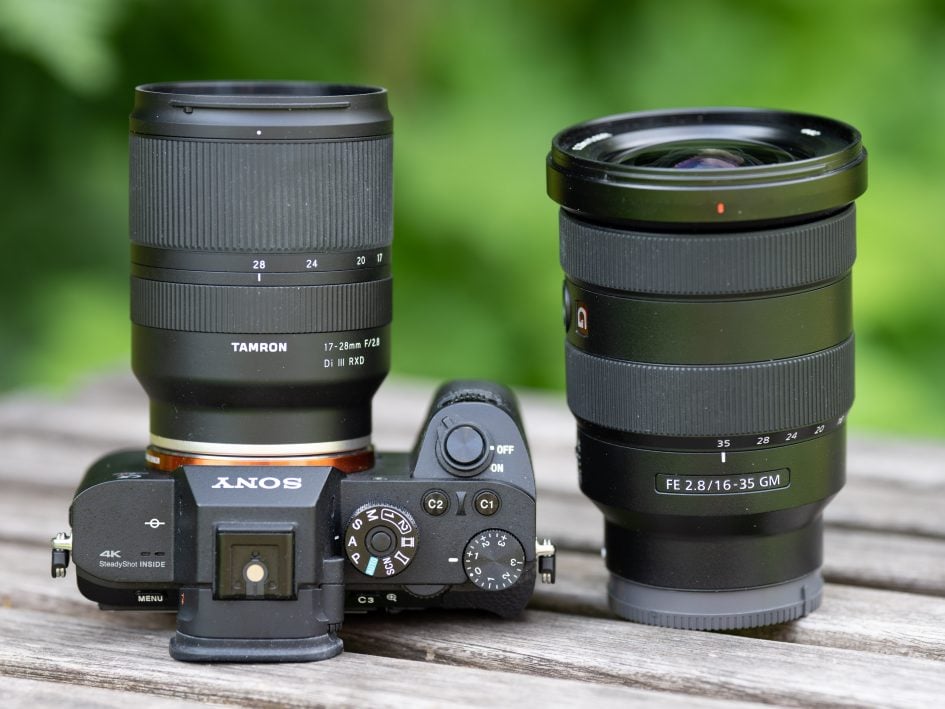
Above: Tamron 17-28mm f2.8 Di III (left) vs. Sony FE 16-35mm f2.8 GM (right)
Alternatives
There is no exact match for Tamron’s new lens. But a classical alternative are 16-35mm zooms of which every big camera manufacturer has at least one version. They all have the added benefit of that extra 7mm (25%) reach:
- Sony has the FE 16-35mm f2.8 GM from 2017 for 2240 EUR / 2200 USD. It’s one of Sony’s G-Master, or GM, lenses, boasting the company’s best optical quality to date. See Gordon’s Sony FE 16-35mm f2.8 GM review-so-far which I’ll be updating to a full review shortly.
- If you don’t need a focal ratio of f2.8 Sony also offers the stabilized FE 16-35mm f4.0 ZA OSS selling for 1050 EUR / 1350 USD. But that lens is still longer by 1cm and heavier by 100g than Tamron’s new zoom.
Or you can go for ultra-wide angle zooms as an alternative:
- The Sigma Art 14-24mm f2.8 DG DN is an original mirrorless design for E-mount which should soon be available (1530 EUR / 1400 USD). It is the largest (85x131mm) and heaviest (795g) alternative. This lens is not to be mistaken for the Sigma Art 14-24mm f2.8 DG HSM, a DSLR design from 2018 which is much bulkier and heavier still.
- Go even wider with Sony’s FE 12-24mm f4.0 GM from 2017 (1700 EUR/USD). The lens is 87x117mm and weighs 565g. For more information and sample images have a look at Gordon’s Sony FE 12-24mm f4G review so far.
With both ultra-wide angle zoom lenses you lose 4mm (15%) reach on the long end compared to the new Tamron. But for that you gain 10 degrees (Sigma) resp. 18 degrees (Sony) angle of view on the short end. And that extra coverage is very visible. Be aware though that due to the bulbous front element both ultra-wide zooms cannot use standard filters.
Here is the angle of view that the new Tamron 17-28mm f2.8 Di III covers with its 1.6x zoom:

Above: Tamron 17-28mm f2.8 Di III coverage on Sony A7R II full-frame body at 17mm (left) and 28mm (right), JPG straight out of camera with Distortion Compensation = Auto
The Sony FE 16-35mm captures a visibly wider range with its 2.2x zoom:

Above: Sony FE 16-35mm f2.8 GM coverage at 16mm (left) and 35mm (right), JPG straight out of camera with Distortion Compensation = Auto
Focus and zoom
Focus accuracy and repeatability is critical to consistently produce sharp shots. Repeatability (the accuracy of focus on the same subject after repeated focus-acquisition) of this lens at 28mm focal length is good (measured 97.2% in Reikan FoCal) with no outliers over a series of 40 shots on a A7R II. There is some focus variation with the lens hitting the (focus-) mark better when coming from a closer distance. At 28mm focal length the lens focuses quickly in around 0.5 sec from infinity to 0.38m (1:10 magnification).
The zoom ring turns through 65 degrees the way Sony users are used to and has a 31mm wide rubber surface with a good grip. It turns pretty stiff and can hardly be operated with one finger. The focus ring is 13mm wide and is located closer to the camera. It moves very smoothly and can easily be operated with one finger.
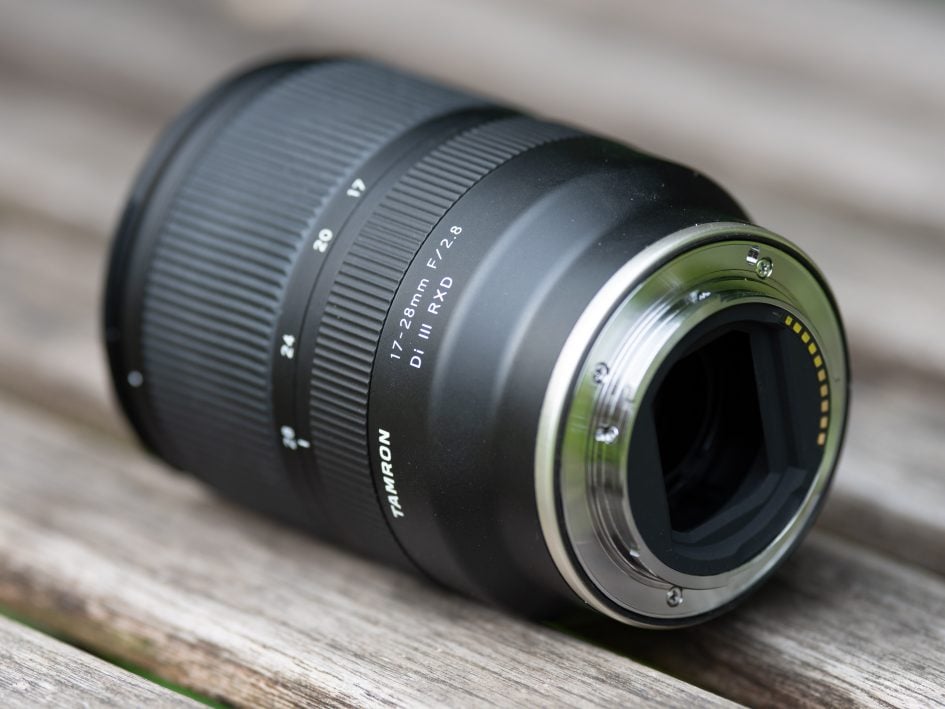
AF-operation of the new lens and image stabilization of the A7R II is inaudible from the outside and when you record video with the built-in microphone. As you pull focus, you’ll notice some focus breathing: the image becomes a little more magnified at closer focusing distances. When I adjusted the focus from infinity to 0.38m (1:10 magnification) on the new Tamron at 28mm focal length, I measured a 2% increase in magnification. The same test at 17mm focal length did only produce a 1% increase. So the new Tamron produces very little focus breathing when recording video.
Next check out my quality results!
Check prices on the Tamron 17-28mm f2.8 Di at B&H, Adorama or WEX. Alternatively get yourself a copy of my In Camera book or treat me to a coffee! Thanks!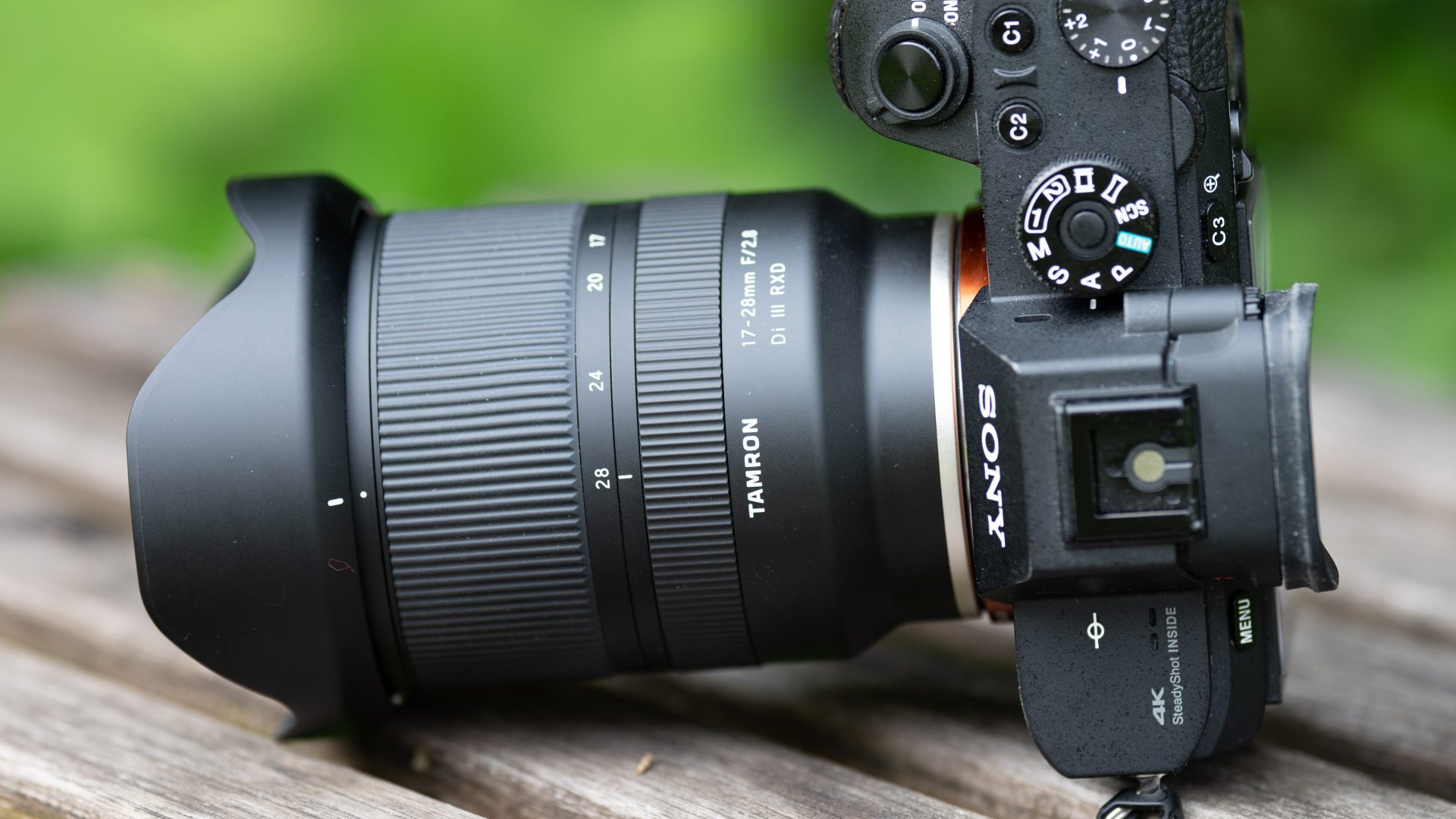
 The 17-28mm f2.8 Di III RXD is Tamron's second native lens designed specifically for Sony's full-frame mirrorless E-mount bodies. From my tests Tamron's 17-28mm seems to follow in the footsteps of their 28-75mm f2.8 Di III RXD standard zoom: it offers a constant f2.8 focal ratio, is sharp to very sharp, shows very good resistance against flare and glare in challenging contra-light situations, and offers useful performance in close-up shooting. The lens is also pretty small and light. So light in fact that both the 17-28mm plus the 28-75mm f2.8 Tamron zooms together weigh only 1kg although they offer a constant f2.8 aperture throughout the zoom-range. And crucially you can get both at a price below that of Sony's FE 16-35mm f2.8 GM. What's not to like? Well, the 1.6x zoom range can feel pretty limited at times, the working distance at close-up shooting is a very short 6cm making it pretty hard not to throw a shadow on your subject and scare little critters away, and the full-frame corners are a bit soft when shooting at around 1-2m distance. But most of us want an ultra-wide zoom for more distant subjects where the Tamron excels, indeed equalling or even surpassing the sharpness of the Sony GM at times. So if you can live with the somewhat limited 1.6x zoom range, Tamron's second native E-mount lens earns a clear recommendation and becomes even more compelling when paired with the 28-75mm.
The 17-28mm f2.8 Di III RXD is Tamron's second native lens designed specifically for Sony's full-frame mirrorless E-mount bodies. From my tests Tamron's 17-28mm seems to follow in the footsteps of their 28-75mm f2.8 Di III RXD standard zoom: it offers a constant f2.8 focal ratio, is sharp to very sharp, shows very good resistance against flare and glare in challenging contra-light situations, and offers useful performance in close-up shooting. The lens is also pretty small and light. So light in fact that both the 17-28mm plus the 28-75mm f2.8 Tamron zooms together weigh only 1kg although they offer a constant f2.8 aperture throughout the zoom-range. And crucially you can get both at a price below that of Sony's FE 16-35mm f2.8 GM. What's not to like? Well, the 1.6x zoom range can feel pretty limited at times, the working distance at close-up shooting is a very short 6cm making it pretty hard not to throw a shadow on your subject and scare little critters away, and the full-frame corners are a bit soft when shooting at around 1-2m distance. But most of us want an ultra-wide zoom for more distant subjects where the Tamron excels, indeed equalling or even surpassing the sharpness of the Sony GM at times. So if you can live with the somewhat limited 1.6x zoom range, Tamron's second native E-mount lens earns a clear recommendation and becomes even more compelling when paired with the 28-75mm.



